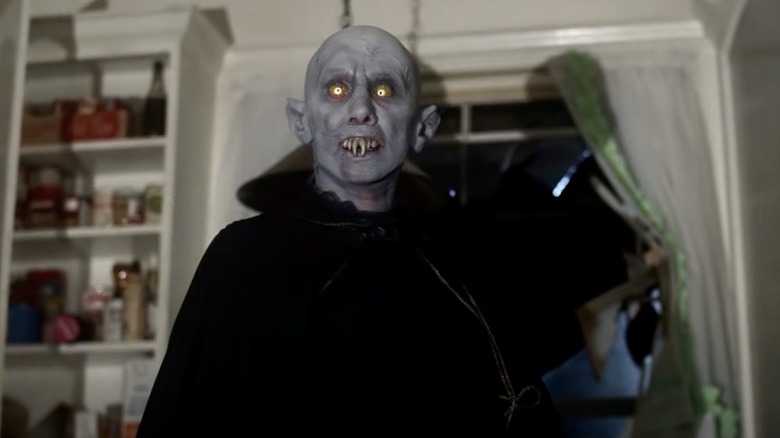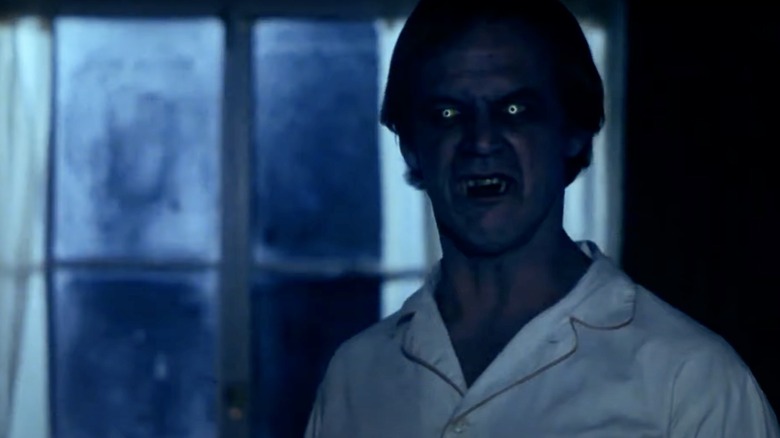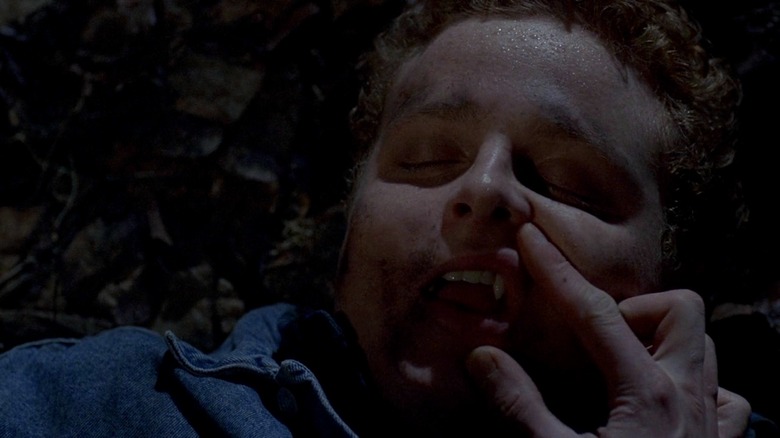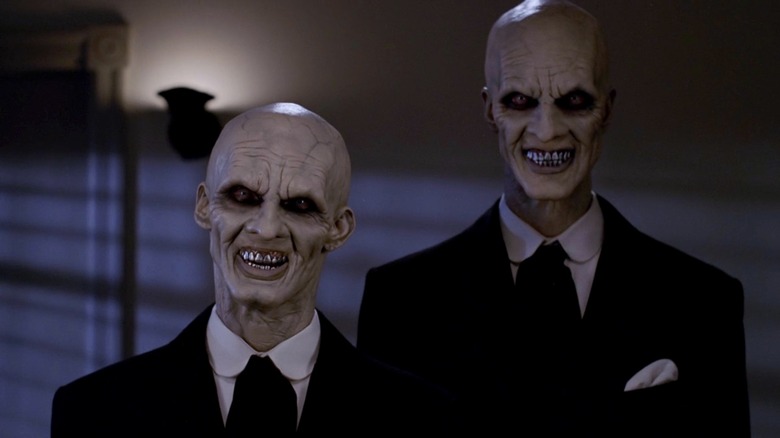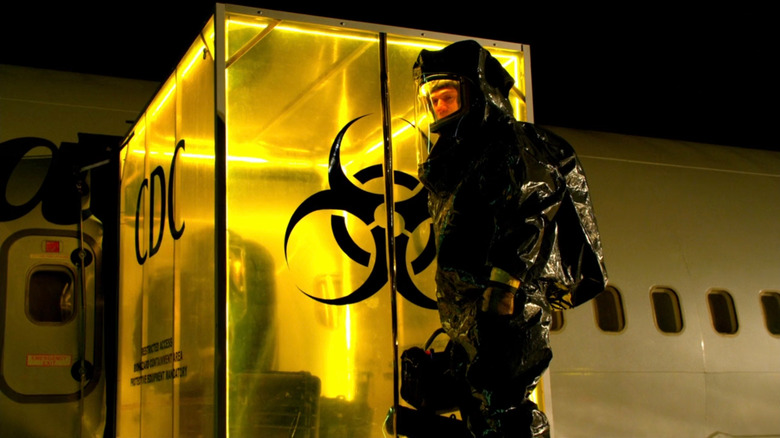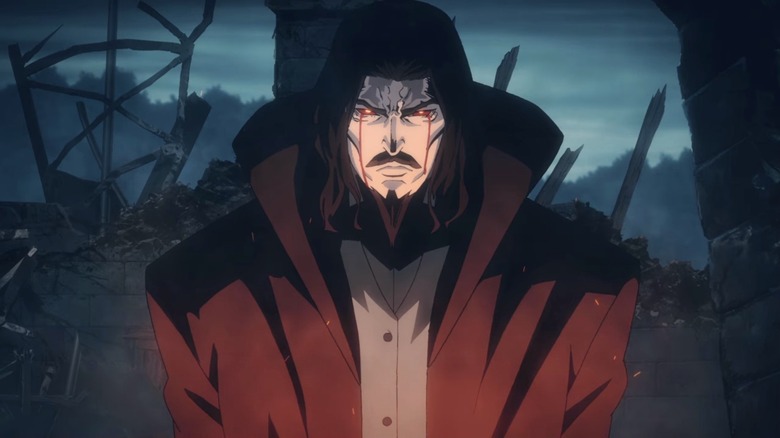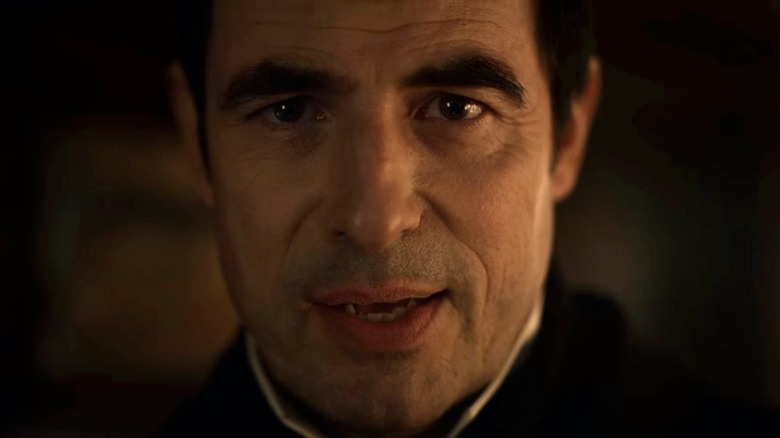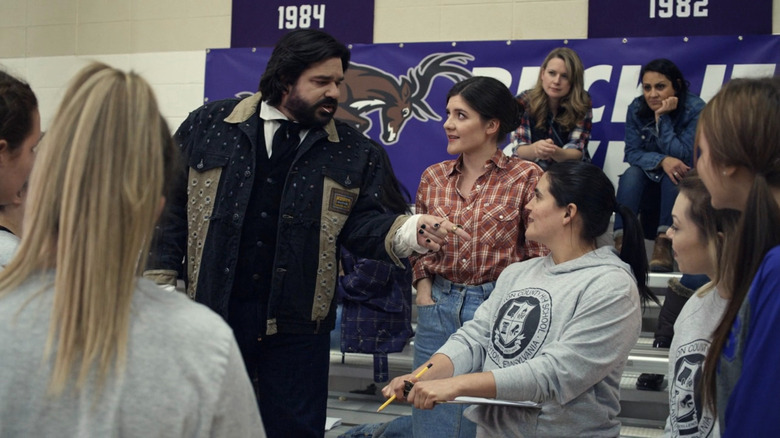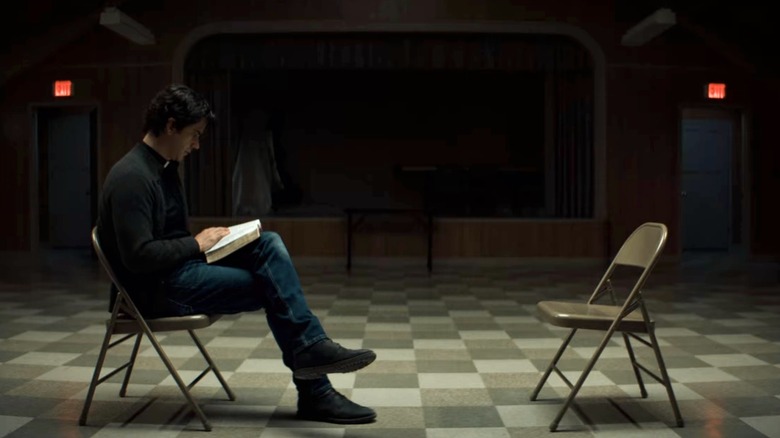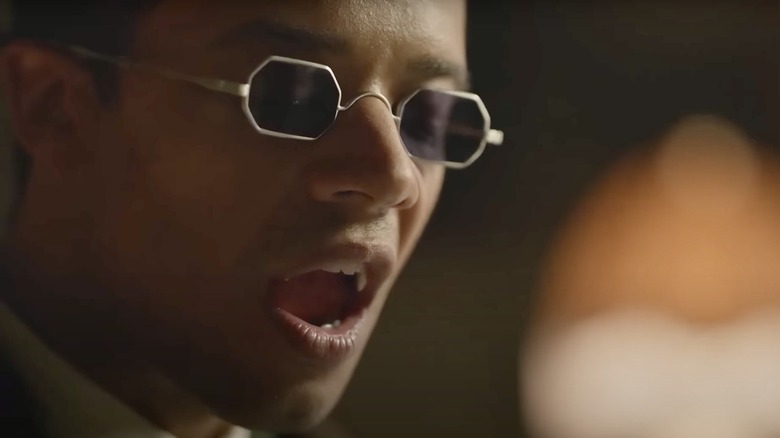Year Of The Vampire: 9 TV Miniseries And Standalone Episodes That Don't Require An Eternal Bloody Commitment
(Welcome to Year of the Vampire, a series examining the greatest, strangest, and sometimes overlooked vampire movies of all time in honor of "Nosferatu," which turns 100 this year.)
Unlike vampires themselves, the best stories arguably don't go on indefinitely. Think about it: would you really want to keep watching the same vampire show (or any show), with no end in sight, for all eternity? At the very least, you'd probably want an intermission of a few years, some time to unplug, think about your life choices, and hibernate in your coffin.
In the Year of the Vampire series, we've been focused almost exclusively on movies. The one TV show we revisited back in March was "True Blood," but even that show lasted seven seasons and 80 episodes. It requires a real time commitment. And if you're new to a show, the prospect of that can be daunting, especially during the Peak TV era, with so many streaming titles out there, new and old, vying for the viewer's attention at all times.
I can personally vouch for the 12-episode first season of "True Blood." It was trashy good fun, but as much as I enjoyed it, I never made it any further than that, if for no other reason than because I'm a viewer who's always looking for self-contained stories and jumping-off points for ongoing or seemingly never-ending narratives (undead or otherwise).
This chronological list of nine vampire miniseries and standalone TV episodes presupposes that the reader is also a mortal who doesn't have all the time in the world. Maybe you're interested enough in vampires to go beyond movies but you're not ready to enter a multi-season relationship yet. If so, suck on these bloody yet mercifully brief additions to the small-screen vampire canon.
Salem's Lot (1979)
I remember how excited I was back in the early 2000s when I heard about the talented cast they were assembling for a new TNT miniseries based on Stephen King's vampire novel, "Salem's Lot." It's the same feeling many King fans are probably feeling now with the upcoming feature film adaptation.
The book imagines what would happen if a vampire like Dracula came to a small town in 20th-century New England (where else but Maine?) rather than 19th-century London. Yet the actual TNT series, when it arrived, lacked the bite of the original CBS adaptation, which clocks in at just over three hours now if you watch it without commercials.
Directed by Tobe Hooper ("The Texas Chain Saw Massacre," "Poltergeist"), the 1979 version of "Salem's Lot" looks its age but also boasts a spooky haunted house (the Marsten House), a memorable vampire's familiar (Richard Straker, played with sinister conviction by James Mason), and a pile of other effective scares. More than one scene sees bloodsuckers — including a creepy little boy who likes scratching at the glass — floating in or falling out of windows.
White-haired schoolteacher Jason Burke (Lew Ayres) steps down the hall to a bedroom, where his former student, now a grey-skinned vampire, sits in a chair, rocking back and forth hypnotically. The vampire, which used to be a man named Mike Ryerson (Geoffrey Lewis) turns his glowing eyes up at Burke and says, "Look at me, teacher..."
"Salem's Lot" itself holds the same mesmerizing power. The rat-like Kurt Barlow (Reggie Nalder) marked a return to the Count Orlok school of vampirism; his arrival sets off a chain reaction of undead transformations in Jerusalem's Lot. If you haven't heard, America is overrun by vampires, and this cursed town is a microcosm for it.
The X-Files, season 5, episode 12, 'Bad Blood' (1998)
Fox Mulder is a fount of vampire knowledge. The indefatigable want-to-believer and FBI agent played by David Duchovny knows all about Chinese hopping vampires and every other bloodsucker under the moon. In "Bad Blood," Mulder hits the ground running — literally — chasing down a seemingly vampiric pizza delivery boy and staking him through the heart, right at the start.
The only problem? The kid was wearing fake fangs! Not a good look, Mulder.
Chris Carter, the creator of "The X-Files," has said that the show was directly inspired by the short-lived '70s TV series "Kolchak the Night Stalker," which arose out of a TV movie about a reporter investigating a string of vampire killings in Las Vegas. It's only right that "The X-Files" would later bring in Kolchak himself, actor Darren McGavin, in a couple of guest spots as the aging Arthur Dales, proto-Mulder of the McCarthyite 1950s.
The beauty of "The X-Files" and its format is that it alternates mythology-driven episodes with monster-of-the-week ones. Written by "Breaking Bad" creator Vince Gilligan, "Bad Blood" falls in the latter category. Just a few episodes before Dales made his show debut, it delivered a one-off, "Rashomon"-style vampire narrative where Mulder and Dana Scully (Gillian Anderson) take turns recounting the events that led up to Mulder's hasty staking of the pizza guy.
Patrick Renna plays said guy, Ronnie Strickland, and none other than Luke Wilson plays the sometimes-bucktoothed sheriff of the small Texas town where this all transpires. "Bad Blood" has some delightful twists and turns that I won't spoil here, but do take note: "Sesame Street" vampire Count von Count isn't the only potential bloodsucker who is prone to obsessive-compulsively counting. And if you see a suspected vampire, you can always fashion a makeshift cross out of breadsticks.
Buffy the Vampire Slayer, season 4, episode 10, 'Hush' (1999)
As /Film's Jamie Gerber writes, loving "Buffy the Vampire Slayer" is complicated. The show's legacy has been tainted in recent years due to allegations of a toxic on-set environment, run by a former geek god who's been accused of being as much a vampire as the ones he wrote. Yet this show was the work of more than one person, and there's no denying that "Buffy" is an important part of vampire history.
At its best, "Buffy" used bloodsuckers and other monsters as metaphors for everyday fears and problems faced by young adults—or anyone. One of the show's most enduring standalone episodes, the half-silent "Hush," has Buffy (Sarah Michelle Gellar) and her Scooby Gang facing off against fairy tale creatures called The Gentlemen (led by monster-actor extraordinaire Doug Jones), who suck people's voices from them in lieu of blood.
The first act presents a typical day in the life of the show's characters, and it's somewhat predicated on the viewer's knowledge of existing relationships. But even if you've never seen a single episode, you can probably follow along with it in media res. Things kick into high gear once the town of Sunnydale is rendered speechless and the Gentlemen and their straitjacketed goons start floating into dorms, knocking on doors, and inviting themselves in, to carve out hearts.
"Hush" is not entirely without true vampirism, as Spike (James Marsters) jokes about crumbling up Weetabix in blood, and we see him drinking a chilled mug of it before morphing into his evil, yellow-eyed, caveman-browed vampire self. However, the episode hinges on the fear of not being heard and/or having nothing to say, as we see with Tara (Amber Benson, making her first appearance) when she tries to speak up at a Wicca meeting.
The Strain, season 1, episode 1, 'Night Zero' (2014)
"The Strain" is the "Contagion" of vampire TV. The show lasted four seasons, but Guillermo del Toro completists can watch the series premiere (which he directed and co-wrote with Chuck Hogan based on their eponymous book) as a self-contained short story. All you need to know is that the vampire apocalypse happened, and this is how it started.
Corey Stoll plays the chief medical officer of the Centers for Disease Control in New York, and if that sounds like a character ripped from the headlines of the 2020s, consider the following monologue that he delivered in front of a plane of exsanguinated passengers in 2014:
"How often do you touch your face? In a day? How often? Every three minutes. You have mouth-hand contact every five minutes. You touch somebody else every twenty minutes. That's how contagion works. You know, like terrorists? Try negotiating with a virus. A virus exists only to find a carrier and reproduce. That's all it does, and it does it quickly. It has no political views. It has no religious beliefs. It has no cultural hangs-ups. It has no respect for a badge. It has no concept of time or geography. It might as well be the Middle Ages, except for the convenience of hitching a ride on a metal tube, flying from meal to meal to meal. That's how a plague begins."
The vampire plague crosses the bridge into Manhattan, with love guiding the infected back to their homes and families. As Holocaust survivor, pawnbroker, vampire hunter, and keeper of formaldehyde hearts Professor Abraham Setrakian (David Bradley) roundly observes: "It feeds on us and we feed on it."
Castlevania, season 1 (2017)
Executive producer Adi Shankar originally described "Castlevania" as a "super violent" animated "miniseries," based on Konami's dark fantasy video game. However, the day it hit Netflix, "Castlevania" was immediately renewed for a second season. The four-episode first season ends in such a way that it's clearly setting up a future showdown, but it only has a 94-minute runtime, so you could watch it and decide if it's for you in about the length of a short movie sitting.
The story begins with Vlad Dracula Tepes, voiced by Graham McTavish, meeting and marrying a mortal woman, only for the local Bishop (Matt Frewer) to burn her at the stake for her scientific "witchcraft." Clergymen aim crosses at her even as she echoes the words of the crucified Christ, speaking to the sky and saying, "They don't know what they're doing."
Needless to say, her vampire husband doesn't take this well. Appearing as a fiery face, Dracula tells the people of Wallachia they have one year to get their affairs in order before he kills them all. It's like he's "The Green Knight," only genocidal. What's interesting is that, rather than flee or band together and fight, the people and their knife-wielding priests would rather assign blame for their misfortunes to other humans: nobles and scholars such as the Belmonts and Speakers, led by Trevor Belmont (Richard Armitage) and Sypha Belnades (Alejandra Reynoso).
When a six-eyed demon waltzes into your church and tells you your life's work makes God puke, you know you're probably doing things wrong. The only hope for Wallachia as Dracula lets loose a horde of Night Creatures on it may be Trevor, Sypha, and the "floating vampire Jesus," Alucard (James Callis).
Dracula (2020)
Before his character Fjölnir's name became a byword for treachery in a Viking revenge mantra (see: "The Northman"), Claes Bang ushered in the 2020s by starring as the titular Count in this three-episode Netflix and BBC One adaptation of "Dracula." Written by Mark Gatiss and Steven Moffat, the creators of "Sherlock," the "Dracula" miniseries makes Van Helsing (Polly Wells) a faithless warrior nun named Agatha instead of Abraham. At the convent, she tells the visibly vampiric Jonathan Harker (John Heffernan), "Like many women of my age, I'm trapped in a loveless marriage, maintaining appearances for the sake of keeping a roof over my head."
That's just one of the liberties "Dracula" takes as it gives the source material of Bram Stoker's novel a 21st-century facelift. "Saint Maud" and "The Rings of Power" star Morfydd Clark plays Mina Murray. The whole second episode, "Blood Vessel," is set on the Demeter, the ship that traditionally carries Dracula to England (and is the subject of its own Universal film, "The Last Voyage of the Demeter," coming your way later rather than sooner, in the summer of 2023). On board the ship, we learn new tricks for warding off a vampire, like surrounding yourself with a circle of Bible pages.
It's enough to say, perhaps, that "Dracula" blows a little off course, leading to a highly unorthodox — some would say, shipwreck of a — finale, which might undo some of the goodwill engendered by the previous two episodes. While the ending drew mixed reviews, among other things for its treatment of Lucy Westenra (Lydia West), it typifies the overall dare-to-be-different approach of this umpteenth retelling of the Dracula legend. And the voyage there is never less than interesting.
What We Do in the Shadows, season 2, episode 6, 'On the Run' (2020)
A simple toothpick disguises vampire lecher Laszlo Cravenworth (Matt Berry) as easily as Superman's Clark Kent glasses. In "On the Run," Laszlo's famous one-off "What We Do in the Shadows" adventure as Jackie Daytona sees him leaving behind his bloodsucking roommates on Staten Island for Pennsylvania—because it sounds like Transylvania. What better place to escape the wrath of Jim the Vampire (Mark Hamill), who has sworn vengeance on Laszlo for not paying his last month's rent 167 years ago?
In Pennsylvania, no one knows Laszlo is a vampire. He can reinvent himself as Jackie Daytona, a "regular human bartender" who doubles as the heart and the soul of a local girls' volleyball team. Integrating into human society doesn't mean he's reformed; he still murders the previous owner of Lucky's Bar & Grill. Yet by taking the name of a beach that's a popular vacation destination, Jackie Daytona becomes a "Simply Irresistible" beacon of the week-long getaway everybody needs.
"I think we could all use a bit of Jackie Daytona time and again," he observes. Despite being immortal, Laszlo/Jackie can't outrun his responsibilities forever. Jim the Vampire eventually catches up with him, elbowing up to the bar and ordering a "human alcohol beer" before a full-on vampire barroom brawl ensues, complete with pool cue crosses.
"On the Run" is funny, but it also might be relatable to anyone who's ever taken a vacation and felt like they were "a different person" in that time, only to return to their life and job and be met with an unimpressed shrug. Matt Berry's voice may be the single best part of "What We Do in the Shadows," and this Emmy-nominated episode allows you to mainline it.
Midnight Mass (2021)
This list started with "Salem's Lot;" now, we've reached the equivalent of Salem's Island, where drinking the Kool-Aid à la Jonestown could bring vampire transformation.
I've never sat down in a confession booth like we see Father Paul Hill (Hamish Linklater) do in "Midnight Mass," but I did attend a Christmas Eve candlelight service last December where the carol "Silent Night" was sung. Let's just say hearing a hymn like that in that darkened setting with flames flickering around you hits a whole lot differently after you've seen "Midnight Mass."
Across the seven episodes of this Netflix miniseries, written and directed by Mike Flanagan ("Doctor Sleep"), there's a bit of speechifying in the dialogue sometimes. You almost wish characters would have a more sustained back-and-forth so that it was true dialogue and not just a monologue where one sits silent and listens to the other, only occasionally interjecting. That goes along with the nature of a sermon, however, and this pop-culture sermon — from the frock to Flanagan's horror flock — happens to be quite chilling.
Much of the fifth episode is devoted to a man-to-man Alcoholics Anonymous meeting between Father Paul and atheistic Christ figure Riley Flynn (Zach Gilford). Before Riley sits down and they're framed between two emergency exits, there's a fleeting image where Father Paul sits opposite an empty chair, reading the Bible. Is he truly alone or is that chair occupied? These are the kind of thoughts "Midnight Mass" provokes.
Father Paul believes in telling small lies in the Lord's service. There's a line where he talks about cleansing his conscience and "finding grace where the guilt should be." I suspect it's the other way around for some Catholics: they find guilt where the grace should be.
Interview with the Vampire, season 1 (2022)
Though she's credited as an executive producer, Anne Rice sadly didn't live to see her 1976 novel "Interview with the Vampire" realized as a television series. As of this writing, the first two (of seven) episodes of the series are available to stream on AMC+, so although it was renewed for a second season ahead of its premiere, you can still get in on the ground floor.
Jacob Anderson is quite charismatic as Louis, reimagined here as a hale and hearty hero with a higher pulse and without the morose inclinations of Brad Pitt's version of the character. Before he receives the Dark Gift, Louis is a well-dressed pimp in Storyville, which sounds like a euphemism for a showbiz entertainer. The series itself has a tap-dancing verve, and it's cognizant that it's peddling a "do-over."
It almost starts out like a sequel to the 1994 film, with Eric Bogosian's older, world-weary journalist Daniel Molloy having botched an interview with Louis decades earlier. References to MasterClass and the pandemic, cosmopolitan shots of Dubai, the use of vampire telepathy, a hot and heavy threesome, a floating, butt-naked vampire kiss between men, and a different last sunrise all set this modern update apart, even as it resurrects abandoned threads from Rice's book like Louis's religious brother and the church confession-turned-bloodbath.
Un petit coup, "the little drink" (as opposed to la petit mort, the little death, or orgasm), awakens feelings of intimacy within Louis. As French flows from his lips, Lestat (Sam Reid) holds a hypnotic power over him. Maybe I'm just in the vampire's thrall like the guys at the poker table, but after one episode of AMC's "Interview with the Vampire," I was all-in. Give it a chance, and you, too, might experience love at first bite.
